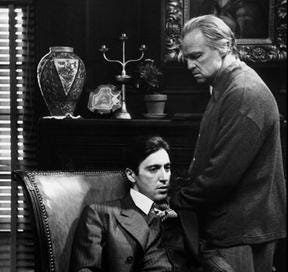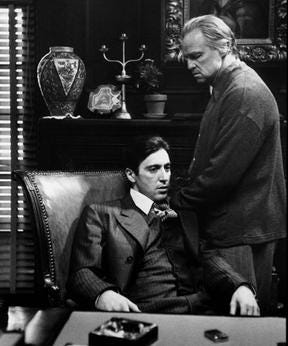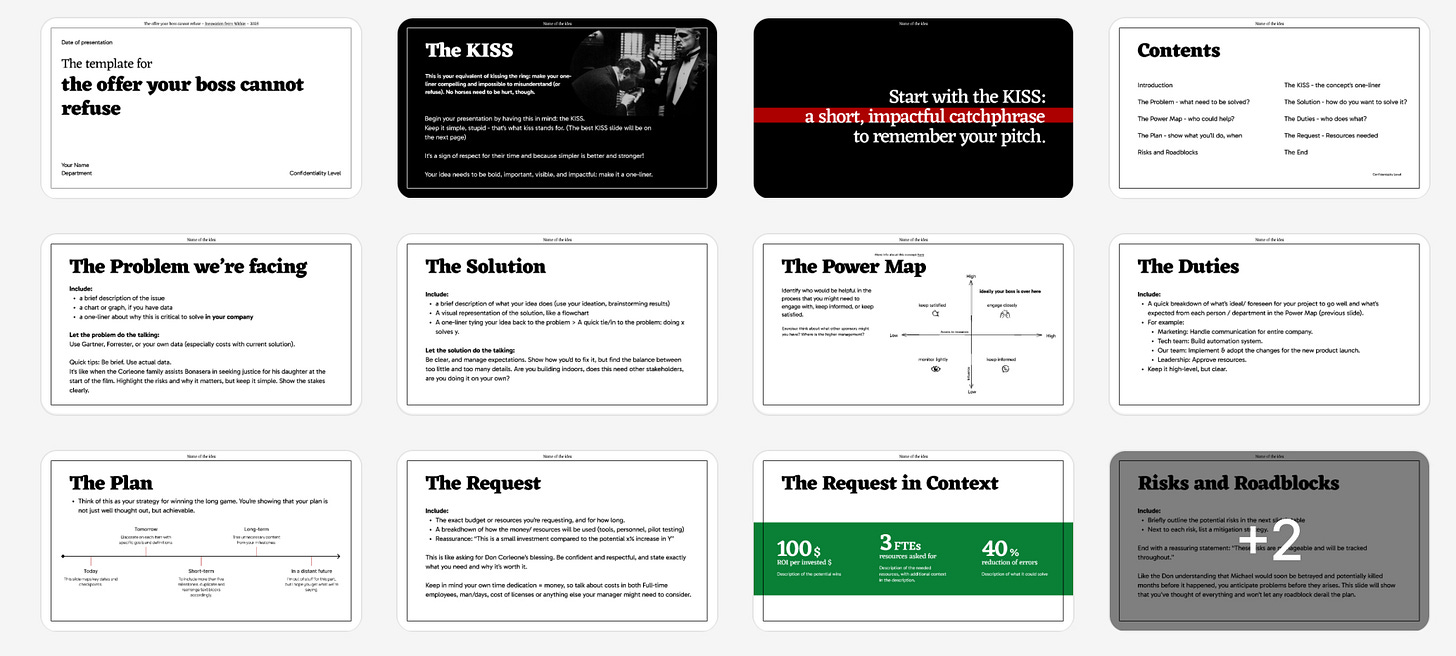It’s time to give your boss an offer he cannot refuse
Great ideas, just minus the deaths. If you kill something, kill the enemies of inaction: loss of profit, loss of resources, or whatever it is you want to solve
Happy Sunday!
Here’s a fact about me that sometimes bothers some close friends: I have a rather vast knowledge of pop culture, but sometimes I know the gist without actually knowing the movie. Like Forrest Gump… or until 6 years ago, The Godfather.
Don’t get me wrong, I knew A LOT about The Godfather without having seen it, which just proves how much of a pop culture staple it is. So today, I bring you The Godfather, in a very timely post to help you present your boss with “an offer they cannot refuse” – minus dead horses.
Come along as we dive into the mafia world of 1940s New York and learn some behind-the-scenes trivia from Francis Ford Coppola himself, in a post designed to inspire you to use this beginning of the year time to ask your boss for budget or time to develop that idea you’ve been thinking about! It’s time to put your inaction with your ideas to sleep with the fishes!
What’s the real cost of keeping your ideas to yourself? Must be quite high. An idea that stays in your head doesn’t solve problems, doesn’t inspire change, and doesn’t help anyone: not even you. 2025 is here, budgets are fresh, so make this your year to change that!
Let’s break this down into actionable steps so you can stop hoarding your ideas and start turning them into real solutions at work, with the great lessons from the great Don Corleone! Even if you don’t use this now, make sure to bookmark or save this post/e-mail for future reference!
Why The Godfather Is a Timeless Masterpiece
The first time I finally sat down to watch The Godfather, it wasn’t just a movie or a franchise, but rather a complete experience (especially if you get jump-scared with some of the violence, like me). It wasn’t just about mafia families, violence, or revenge. It was a story about power, legacy, relationships, and strategy.
To Coppola, if it had to be reduced to a single word, it’d be Succession. (Funnily enough, I HAVE seen the TV Show Succession about an Irish mobster-like Media mogul, but that’s unrelated).
Even before I watched The Godfather, I knew the famous lines:
“I’m gonna make him an offer he can’t refuse.” - the inspiration for this post!
“A man who doesn’t spend time with his family can never be a real man.”
“Never tell anyone outside the family what you’re thinking.”
The fact that so many people know these lines, often without context, shows the cultural impact of the film. But watching it all unfold, especially with Marlon Brando’s unforgettable performance as Don Vito Corleone, gave me a whole new appreciation for what the movie really teaches us.
The Plot: Mafia Drama Meets Strategic Genius
The movie opens with a powerful scene. Bonasera , a desperate undertaker (funny that his name could mean good night/evening and he has a funeral home and prepares dead bodies for burial), asks Don Corleone for justice after his daughter is attacked. But he doesn’t ask with respect or friendship, and the Don notices.
“You don’t ask with respect. You don’t offer friendship. You don’t even think to call me Godfather.”
Still, Don Corleone agrees to help, but not without ensuring that Bonasera owes him a favor in return.
This moment sets the tone for the entire movie. It’s not just about being a charismatic problem-solver. It’s about power, relationships, and mutual benefit. And while we’re not here to run a mafia empire, there’s a lot we can learn about how to build trust, manage relationships, and negotiate effectively at work. Things are transactional, or like they’d say in the movie: this is strictly business.
When I Made My Own Offer (and Failed)
A few months ago, I tried pitching an idea to my boss. I had everything I thought I needed: a slick PowerPoint deck, a clear roadmap, even an entire rundown on who could do what, and a budget estimate of what we’d need. But when I made the pitch, it fell flat.
Looking back, I realized I had pulled a Bonasera. I hadn’t done enough groundwork to understand what my boss cared about most. My pitch was all about what I thought was great, not how my idea solved a problem for him. While it was aligned with the company and the team’s values, I failed to answer the most basic question that he always asks, so… I failed to ask myself “What would “My boss” think/do?”. After this failed meeting, my coworker and I looked at each other and laughed: we failed with a very obvious reason.
Six Months Later: A Successful Pitch
Just last month, I had the opportunity to make it better. I’m switching roles, and I gave a pitch to my boss to let me present my ideas for the role, so that it also draws upon my best skills and things I bring to the table. I took a page out of Don Corleone’s book (not literally, we also don’t murder books here). I started by having casual conversations with my boss weeks before the actual pitch, trying to understand his new vision for the team. I listened to his challenges and priorities, and when it came time to present my idea, I framed it as a solution to those exact issues.
I also anticipated objections (my previous failure) and included a plan to mitigate risks. My pitch was less about me and more about how my idea would make him look good while helping the company.
This time, it worked. My boss not only approved the idea but also trusted me with more responsibility.
So… what did I use? Well, that’s to be discovered on the next section:
What Makes Don Vito Corleone Brilliant
Don Corleone is more than just a crime boss, he can even be described as a master strategist. He listens, plans ahead, and builds relationships that ensure loyalty and long-term success. His own son, Michael, is alive, because he predicted his enemy’s move months before it happened. You could say that some are playing a random tic tac toe basic strategy game, but he’s playing chess.
The requests made to Don Corleone often included clear plans for what should happen next. They didn’t just ask for something: people suggested what would happen afterward, showing they had thought things through. For instance when they discuss a potential deal with drug dealers, Tom Hagen (his Consigliere) has a very well-structured piece of advice for the Godfather.
Here’s what we can learn from Don:
1. Build Relationships Before You Need Them: The Don’s power comes from his network. He invests in people so that when he needs something, they’re eager to help. Bonasera, whose daughter is goddaughter of Corleone’s wife, was indebted to him for the “justice” he asked for his daughter’s attackers, and when Corleone’s son is dead, it’s Bonasera that takes care of his body for the funeral.
At work: Build trust with your boss and colleagues before you pitch an idea. Offer help or show support for their projects: it’ll pay off later.
2. Be Calm and Composed: The Don never reacts emotionally. He takes his time to think things through.
Sonny, his son, was the opposite, and that very well be the reason that sets the entire plot into motion, all those killings and vendettas that ensued could probably have been avoided if Sonny hadn’t jumped to ask something. While he still tried to do some damage control, as you can see:
“I have a sentimental weakness for my children and I spoil them as you can see. They talk when they should listen. (…)
To his son: Santino, come here. What's the matter with you? I think your brain is going soft from all that comedy you're playing with that young girl. Never tell anybody outside the family what you're thinking again. Go on.” - (Vito Corleone to his son, Sonny, in the first movie)
At work: Don’t pitch your idea in a rush. Take your time to prepare and stay calm, even if you’re nervous. (I learned this the hard way, haha!)
3. Make It About Them: Don Corleone always makes his deals mutually beneficial.
At work: Frame your idea as a win-win. How does it help your boss, team, or company?
4. Anticipate Risks: The Don is always prepared for things to go wrong. His son Sonny was probably not the best at it… there’s plenty of examples of it happening in the movie.
At work: Address potential objections upfront. Show that you’ve thought through the risks and have a plan to handle them.
Coppola’s Behind-the-Scenes Struggles
The making of The Godfather is a story in itself. Did you know that there’s a TV show about the making of the movie, called The Offer? I haven’t watched it yet, but it shows how eventful the making of the movie was! From Sinatra threatening Puzo… to other stories.
Francis Ford Coppola, the screenwriter, just 29 years old at the time, was nearly fired multiple times during production. The studio wanted to set the movie in the 1970s to save money, but Coppola fought to keep it in the 1940s to stay true to the book.
And then there’s Marlon Brando. The studio didn’t want him because they thought he was “too difficult”. But Coppola insisted (he had to trick Brando into a screen test even, but it all worked out for the best!) and Brando proved why he was the perfect Don. He stuffed cotton in his cheeks, spoke with a raspy voice, and even used shoe polish to darken his blond hair on the screen test (similar to audition, which could be something similar to your post-it ideas before you do anything in reality). These details weren’t just for show, they actually helped Brando, a method actor, become Don Vito Corleone. It’s a great reminder and example that preparation and attention to detail are everything, whether you’re directing a movie or pitching an idea.
Your time to give your boss offer he can’t refuse: A Step-by-Step guide
Inspired by The Godfather, I made a template for you guys!
Here’s the template: link
Here’s the slideshow: link
I know you probably have presentation templates from your company, so use that if it’s the rule… But in case you’d like to know what to include, then the presentation can help you get started!
Here’s what the template includes:
1. The KISS Slide: Start with a one-liner that captures your idea. You have to kiss the Don, right? In this case, please don’t kiss your boss’ ring, but do “keep it simple, stupid!”
2. The Problem Statement: Clearly define the issue you’re solving. If you’ve been able to spot the Pain Point, make sure to tell it to your boss, in a true “This Is Business, Not Personal” fashion. In The Godfather, every move is made to protect and grow the family business. That’s your starting point too. What’s the “business” pain point holding your team or company back?
3. The Solution: Show how your idea addresses the problem. Your Plan Needs 3 Key Elements:
A Clear Concept: What exactly are you proposing? Be specific and concise.
Realistic Budget: What resources, time, or tools will you need? Make sure you’ve accounted for everything so your boss won’t have to.
Market Validation: Why is your idea worth pursuing? Use data, competitor benchmarks, or internal insights to show the potential impact.
For example, if your pain point is disorganized meetings, your pitch could include a simple new agenda format and tools like Notion or Slack integrations to streamline follow-ups.
Pro Tip: Make your pitch about them, not you (that was my hard lesson). Just like Michael positioned his moves as benefiting the family, frame your idea as solving a team or company-wide problem.
4. The Power Map: Assign roles and responsibilities.
5. The Roadmap: Outline the timeline for execution.
6. The Ask: Be specific about the resources you need.
When Michael or Vito spoke, everyone listened. Why? Because they both were deliberate and strategic. To get your boss and colleagues on board, you need to present your idea with clarity and confidence.
Use the template and edit it to make your pitch clear, concise, and compelling.
By addressing every angle: budget, concept, validation, and potential objections, you’re building an offer that feels thoughtful, strategic, and low-risk. When you walk into the room (or hit send on your email!), you’ll have a pitch that leaves your boss nodding instead of questioning.
And just like the Corleones, you’ll position yourself as someone who knows how to handle business.
Final Thoughts: What Would the Don Do?
Whether you’re pitching an idea, negotiating with a client, or solving a problem, think like Don Corleone. Build relationships, prepare thoroughly, and frame your ideas as mutually beneficial.
He also had a great skill I’d like to point out: Active Listening. The Don listens carefully to what others say before responding. He doesn’t interrupt or dismiss ideas, even if they seem minor or irrelevant at first. For instance, while he was very much against that drug deal, he still listened to it from both Hagen, his consigliere, and the man proposing it as the dealer himself.
At Work: Listen to colleagues, clients, or team members without jumping in. People feel respected and are more likely to collaborate when they know they’re heard.
How: Maintain eye contact, let the other person finish speaking, and summarize their key points before responding. This will show your empathy, but also your preparedness for being responsible for this new idea you have.
As we kick off 2025, it’s the perfect time to present your boss with your own “offer they can’t refuse.” I hope this post gets you ready for it.
Now go make your move, consigliere!
Did you enjoy this post? Tell me that via reply to this e-mail or comment! I’d love to hear your thoughts! If you think someone else might enjoy or need this, then share this with your friends, family or colleagues!
Maybe you might enjoy these things I found while researching for this post!
This post has been filled with more than 12 hours of research, and I particularly enjoyed watching some interviews of Coppola, such as:
This interview of Francis Ford Coppola:
Or this one: Facebook link to Howard Stern’s 5 minute snippet.
This book by Francis Ford Coppola about the movie-making process.
The movies: I saw Part 1 and Part 2 this weekend, via Streaming.
The TV show that exists about the movie-making process is called The Offer. It’s a 10 episode tv show and I’m adding it to my soon to watch list!







I'm not pitching anything, but I was enthralled all the same, love how you made so many links that fit so well, did you watch it with a notebook and pen?
Adding the slide download template too is a nice touch, you went all out!
I too had not watched The Godfather until about 6 years ago, but knew many of the references!